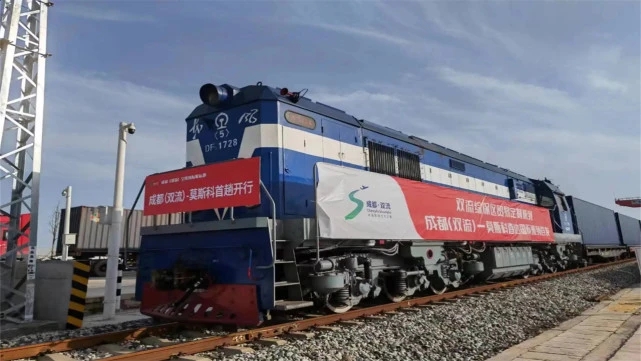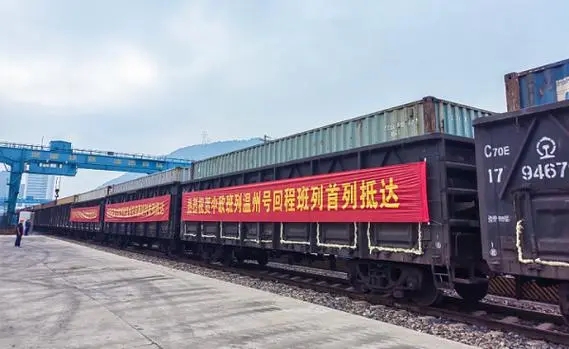Due to the growth of China-Europe investment and trade scale, the "Belt and Road" initiative to promote and grow, in recent years, the China-Europe train has gradually become a link between China and Europe and the construction of the "Belt and Road" countries economic and trade relations, marching in Asia and Europe on the continent of the The "steel camel" constantly focuses the attention of countries along the route.
A few days ago, a round table on boosting the high-quality development of China-European trains, sponsored by China Association for Overseas Development of Industry, was held in Beijing as an important component of the 13th China Foreign Investment Cooperation Fair. As an important hub for the interconnection of the "Belt and Road" countries, the China-Europe Class Train is a key link to stabilize the industrial chain and supply chain of the countries along the route, pointed out Zhenwei, President of China Association for Overseas Development of Industry, in his speech. Accelerate the promotion of China-EU trains and new land and sea channels, such as multimodal transport mode, to build a network of interconnection based on railroads, ports and pipeline networks, which is conducive to the development of countries along the route.
According to Chen Huaikai, director of the regional openness department of the National Development and Reform Commission, by the end of May this year, the total number of China-Europe Class trains has exceeded 72,000, carrying 6.28 million TEUs of goods, with a heavy container rate of 98.3% and a total cargo value of nearly 300 billion U.S. dollars, and the categories of goods carried have gradually expanded from IT products such as computers at the beginning of the voyage to 53 categories and more than 50,000 varieties such as clothing, shoes and hats, automobiles and accessories, and grain. .

"The operation of the China-Europe Class train has tightened the connection between Asia and Europe." Chen Huaikai said, as of the end of May this year, the China-Europe Classes have laid a total of 82 operational lines, reaching 213 cities in 25 European countries, gradually "connecting points into lines" and "weaving lines into a network", the transport service network covers the whole territory of Europe, forming an international transport artery through The international transportation artery through Europe and Asia.
It is worth paying attention to the fact that there are some factors restricting the development of China-Europe Classical Train at present. Li Xinlong, executive director of Hebei Land Port Construction Group, points out that the uneven distribution of China-European Liner consolidation centers is one of the problems, such as the construction has not yet been carried out in the eastern region, so the layout of China-European Liner central stations to develop the Middle East and Southeast Asia is very necessary for the source of goods.
"The capacity of the port is saturated, and the transportation facilities along the route need to be improved." Li Xinlong said, at present, Alashankou, Manzhouli, Erlianhot, Horgos and other ports of transport capacity load running, while the supervision of ports affected by infrastructure, changeover time is longer and logistics storage capacity is insufficient to meet the increasing demand for freight volume of China-European trains, thus reducing the speed of transport, especially the return train is affected by the larger, the port backlog is serious.
At the same time, the number of return cargo source is small, low value, overseas market development is also a major problem. Li Xinlong said, the return train has been empty for a long time, and the return cargo is mostly grain and oil, ore, timber, etc. The shortage of goods is not only the level of economic development and trade structure of China and Europe is not balanced, but also lies in the domestic train operating platform in the overseas layout is less, the market development efforts are not large. Based on the above problems, he put forward the following three suggestions.
First, to integrate dry port resources, optimize the layout of China-EU Liner consolidation centers, and create a number of modern logistics hubs with strong international influence. With the strong industrial strength, high economic density and large population in Beijing, Tianjin and Hebei region, the layout of the established Beijing air port hub, Tianjin seaport hub and Shijiazhuang dry port hub should be fully considered to set up the Central Asia hub of Beijing-Tianjin-Hebei CEB trains in Hebei to meet the needs of the outward-oriented economic development in Beijing, Tianjin and Hebei region.

Secondly, strengthen the facilities connection, improve the railroad capacity and port clearance capacity, and accelerate the construction of domestic key ports card neck section reconstruction and expansion project. The China-Europe Class Train is being transformed from driving products out to industry and capacity investment out, so we should make full use of the Silk Road Fund, Asian infrastructure funds and other banks to raise funds for overseas railroads and port bases to actively invest in improving facilities and equipment at overseas ports, expanding logistics and warehousing capacity, as well as enhancing the supervisory railroad capacity and port clearance capacity.
Third, the layout and construction of overseas warehouses, strengthen the organization of cargo sources of return trains, promote the integration of China-EU trains with local industries, encourage Chinese enterprises to establish production bases, logistics and warehousing, trade centers and overseas warehouses in the areas around the overseas routes of China-EU trains in order to play its transit function. At the same time, it will continue to explore overseas markets, cultivate high-quality customer base, improve cargo collection capacity, seize the opportunities of cross-border e-commerce and other development, improve the mechanism of mutual sharing of information among railroad, customs and postal services, and enhance the efficiency of return trips.
In order to further promote the high-quality development of China-European Liner, Chen Huaikai suggested that it should focus on bottleneck sections and congested ports, actively promote the upgrading of stuck sections of China-European Liner and the expansion of key ports, and expand the new channels between Central and Eastern Europe, Central Asia, West Asia and other countries; effectively strengthen brand management, and enrich the brand of China-European Liner from various aspects such as operational efficiency, service quality, innovation capability, brand culture, etc. The company will innovate the operation management and development mode of China-European Liner, strive to build digital liners, improve multimodal transportation, promote the linkage development of China-European Liner with Silk Road shipping and the new western land and sea channel, create high-quality liners, explore the opening of tourism liners, and accelerate the integration of transportation and trade.

